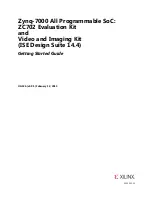
www.topworx.com
23
TM
Fieldbus Foundation Transducer Channel Architecture
The SCM-FF has one transducer block with 13 channels. The 5 DI and 3 DO function blocks will link to these trans-
ducer channels through the standard channel selection capability. (See Function Blocks)
The 13 Transducer Channels are listed below.
Transducer Channels
Notes on Channels
Channels 1 and 5
These are Multi-value DO blocks standard with Fieldbus Foundation. Channel
1 is intended for use with a single control signal, while
Channel 5 is to be used with a dual control signal.
Channels 2, 3 and 4
Channels 2, 3 and 4 use 0 = false and 1 = true for open, close, and stop. This
gives a more comfortable interface for users more familiar with ladder logic. In
the situation where Open and Close are both true (or false) at the same time,
the last input is rejected as invalid.
Readback signals are 0 = false and 1 = true for is-opened, is-closed or is-
stopped. Channels 2, 3 and 4 cannot be used simultaneously with channels 1
or 5.
Channels 4 and 5
Available with a Dual-Control Pneumatic valve.
Channels 6, 7 and 8
Echoes the Readback information from channels 1, 2 and 3.
Channel 9
Reflects the input from a dry contact type of input wired into the
Auxiliary input screw terminals and uses 0 = closed, 1 = opened
reflecting the contact condition.
Channels 10, 11 and 12
Reflects alarm conditions in the valve. When something needs to happen in
response to these error conditions, a DI should be used to publish the state of the
alarm condition. These channels use 0 = false (no alarm), 1 = true (alarm condition
exists). CTOA, CTCA, and CCA are transducer channels that allow alarms to be
scheduled into the system. These alarms are:
Cycle Time Open Alarm (CTOA – Channel 10)
Cycle Time Closed Alarm (CTCA – Channel 11)
Cycle Count Alarm (CCA – Channel 12)
Above inputs are used in preventative maintenance and indicate when a valve is
operating outside of acceptable times. These channels exist so that some action on
the loop can be scheduled in critical applications. Cycle times may increase with an
increase in valve stiction, and/or a loss of air pressure. The times and counts used
as alarm limits are user settable (see Appendix 2).
Regardless of whether these alarms are linked to function blocks, these FF
standard alarms are always reported to the alarm handling host when one of
these conditions exists and the corresponding priority is set to greater than 1.
Channel 13
Stimulates activity when a set of alarm conditions exist. This channel uses a
user-settable mask to allow any of five alarm conditions to cause the linkable DI
parameter to become true. Channel 13 is a masked OR function. It includes the
previous alarms, as well as a Temperature High (TMPH), and Temperature Low
(TMPL) alerts. For TMPH and TMPL, a sensor is used to sense the temperature of
the circuit board. The user can select which of these alerts on Channel 13 are to be
used by masking out the undesired ones.
Содержание DXP-FF
Страница 11: ...www topworx com 11 TM DO DO DO DO DO DO DO ...
Страница 12: ...D Series with FF Option Installation Operation Maintenance 502 969 8000 12 ...
Страница 25: ...www topworx com 25 TM Complete Transducer Parameter Listing cont ...
Страница 37: ...www topworx com 37 TM Warranty ...
Страница 38: ...D Series with FF Option Installation Operation Maintenance 502 969 8000 38 NOTES ...
Страница 39: ...www topworx com 39 TM NOTES ...
















































